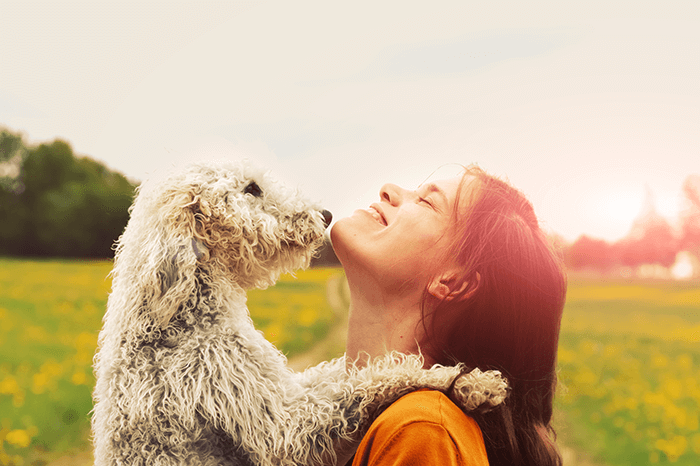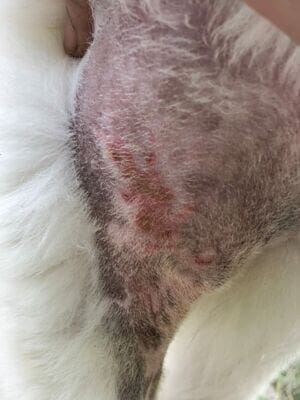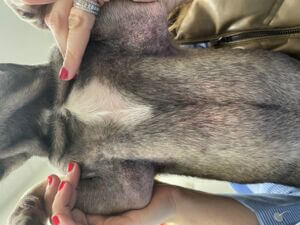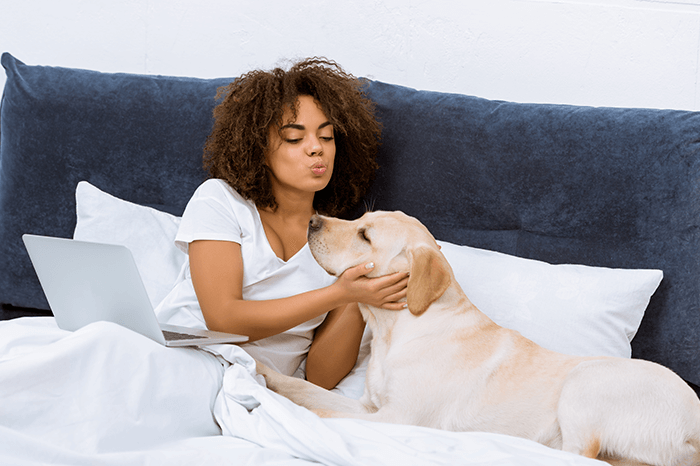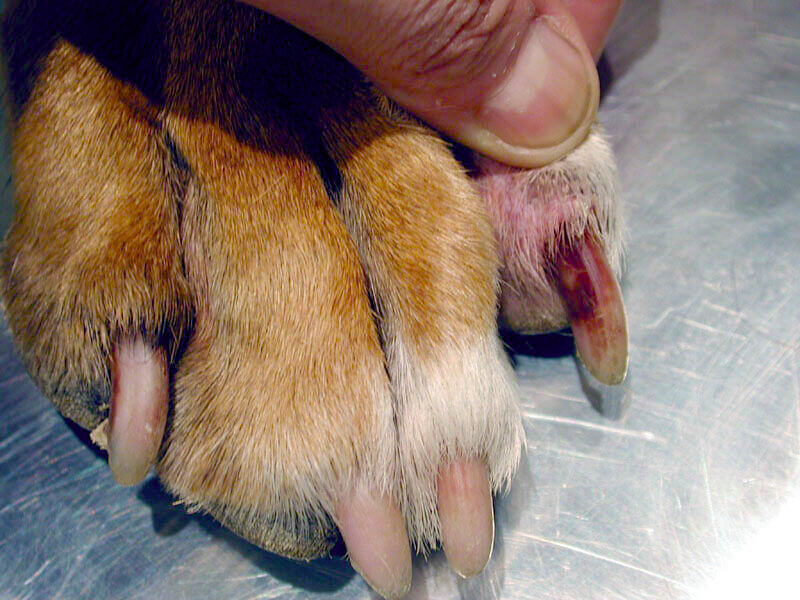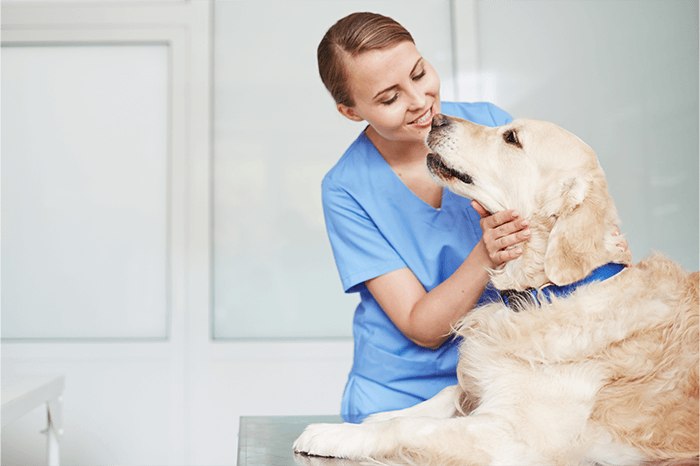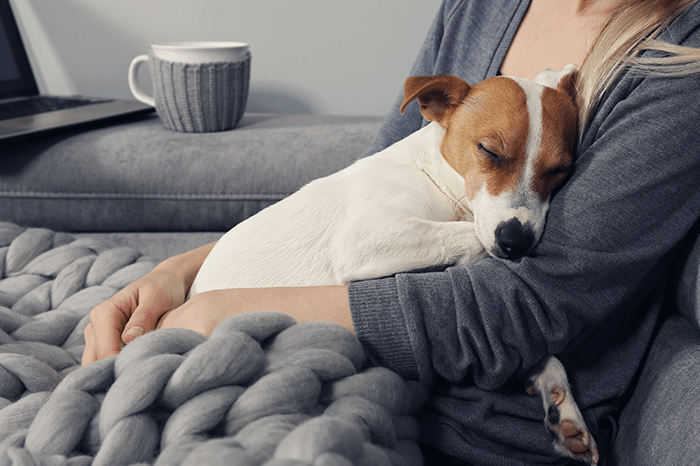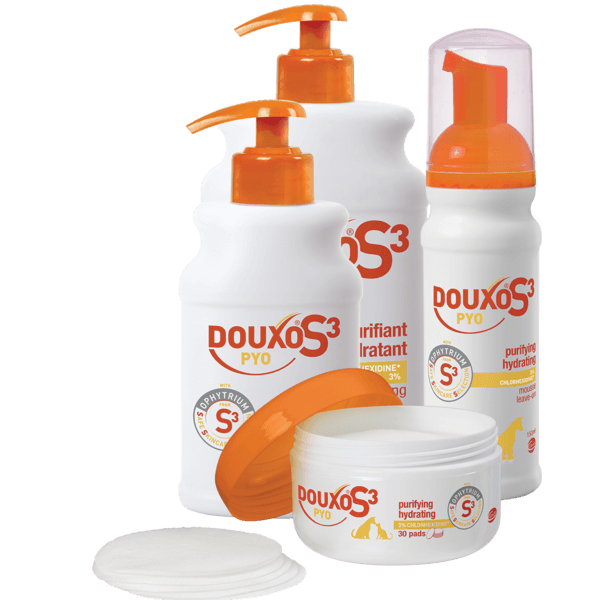All you need to know about yeast dermatitis (Malassezia dermatitis) in dogs
Marina G VeterinarianYeast infections are really common in dogs. They generally occur secondarily to another disorder, either cutaneous or metabolic. Treat the infection and the cause will avoid relapses.
Yeast dermatitis is a common skin condition, caused by the yeast Malassezia pachydermatis. In most animals it causes no harm, however, in cases where there is skin ecosystem imbalance (in case of skin allergies for instance), these organisms overgrow, which can result in inflammation of the skin. Whatever the underlying condition, yeast infection needs to be treated as it is uncomfortable for your pet before investigating the source of the problem.
What are the symptoms of yeast infection in dogs?
Skin
Yeast dermatitis causes red, inflamed and itchy skin, that can feel greasy to touch and sometimes have a sticky discharge. In some cases, the skin may be crusty and flaking, with patches of hair loss. Sores can develop, and the skin may become darker with black spots and thickened, almost resembling elephant skin.
You may notice inflammation is worse in the skin folds around the face, the arm pits, between the toes and around the lips.
Ears
Malassezia can cause recurring ear infections. They often have a characteristic musty smell, and you will often be able to see redness of the ear flap and ear canal, with a brown or yellow discharge.
The ears can become very sore and itchy, causing your dog to shake their head and scratch their ears, and become painful and warm to touch.
Paws
Dogs with yeast infection may have irritated, red and itchy paws, causing them to lick and bite at their paws more than normal. They may have patches of fur loss on their feet, and sometimes they can have a smelly discharge between the pads or around their nail beds. It can also cause a reddish-brown discoloration of the claws.
What causes yeast dermatitis in dogs?
Malassezia, a yeast living on normal skin
Yeasts are naturally present on the dog’s skin and ear canal, and among them, Malassezia pachydermatis are present in low numbers. However, when the skin or ear ecosystem is compromised due to another skin issue or some metabolic conditions, Malassezia yeast can overgrow and cause secondary infection.
Yeast infections, secondary to another conditions
Malassezia dermatitis often occurs secondary to another issue such as:
- Allergies
- Dry or oily seborrhea
- Skin parasites
- Metabolic diseases such as hypothyroidism
- Having a lowered immune system
- A side effect of some medications
It isn’t a contagious condition; your dog will not be able to pick it up from another dog, nor pass it on.
Malassezia dermatitis is more common in climates with higher humidity, and in places on the body that hold more heat, such as skin folds, ears and between the paws.
Are there breed disposed to yeast infection?
Although no breed of dog is immune to yeast dermatitis, some breeds are more susceptible to develop this condition as they are more prone to primary conditions that weaken the skin barrier. Dogs with long thick coats, long ears or excessive skin folds are prone to yeast dermatitis, including but not limited to the Bulldog, Poodle, Pug, Basset hound, Boxer, Cocker Spaniel, West Highland White Terrier, Dachshund, Shih Tzu, Golden Retriever, Labrador Retriever and English Setter.
How is yeast infection diagnosed?
Diagnosis is achieved by your veterinarian by your dog’s history, clinical signs and diagnostic tests such as an impression smear. Under the microscope, your vet will be able to visualise the classic boot-shaped organisms of Malassezia, and if present in high numbers it is a positive diagnosis for Malassezia dermatitis. The method of collecting these samples can include:
- Impression smear: involves pressing a microscope slide directly on the surface of the skin
- Tape strip: applying a tape strip directly on the surface of the skin
- Cotton swab sample: rubbing a cotton swab over the ear canal to pick up cells
Further tests may be required to rule out underlying conditions that cause the Malassezia to proliferate. These include general blood and urine tests, testing for allergies, or testing for other skin parasites such as mites. It is also important to review any medication your dog is already taking, such as steroids or other medications that may suppress the immune system.
How is yeast infection in dogs treated?
Treatment can involve several different approaches depending on the severity of the infection, and any underlying conditions found. The intention is to reduce the number of yeast cells back to normal levels again, and hopefully then solve the secondary inflammatory response.
Topical treatment to suppress yeast growth, soothe the skin and repair the damaged skin barrier
Antiseptic products, such as DOUXO® S3 PYO Shampoo and DOUXO® S3 PYO Mousse are the mainstay method of treatment. These products contain antifungal molecule suchas chlorhexidine digluconate to help inhibit the overgrowth of organisms, whilst cleansing and disinfecting the skin without drying out skin. DOUXO® S3 PYO formula also contains Ophytrium, a natural extract which strengthens the damaged skin barrier and soothes irritated areas thereby optimising the skin’s overall health.
Bathing with the shampoo is normally required at the start of treatment, followed by mousse application every 48-72 hours for three weeks, or as advised by your vet.
If the yeast infection is localised to a certain area, such as skin folds or paw pads, DOUXO® S3 PYO Pads are available to use once daily for local application.
Improvement is generally seen within one week of application but recovery is achieved after several weeks of application (generally speaking, not before 3 to 4 weeks of use).
Oral antifungal if needed
In more severe and persistent cases of Malassezia dermatitis, oral anti-fungal medication can be required. This may be used concurrently with antibiotics to control the bacterial skin infection if present.
Medication is usually given for prolonged periods of time. It is best used in conjunction with topical treatment to help soothe and repair the skin barrier.
Treatment of underlying conditions
It goes without saying that addressing any underlying issues is going to result in greater success of treatment. This includes treating allergies, metabolic diseases with medication, concurrent skin infections, or parasite treatment if indicated.
What is the prognosis?
The prognosis for yeast dermatitis generally is good, however often requires long-term management of the underlying cause. If the underlying condition has been controlled, then the secondary or recurrent yeast infections are reduced, so it is important to work with your vet to come up with an appropriate treatment that is best for your dog. As always in medicine, there is never a ‘one size fits all’ approach, and therapy will be tailored based on the severity of disease and responsiveness to treatment.
How can I prevent yeast infections in my dog?
Controlling underlying allergies, if present, is an important first step in the prevention of yeast dermatitis. Working with your vet to find the best treatment plan for your dog is important, knowing that this plan usually relies on several initiatives at the same time and can evolve over the time.
Keeping your dog’s fur trimmed and clean, and ensuring they are dried properly when in contact with water will help prevent flare ups. Your vet will recommend whether and how often bathing is required.
If your dog has skin folds, then maintenance hygiene of these skin folds with a product such as DOUXO® S3 CALM Pads may help prevent Malassezia dermatitis within these folds and regular use of these pads may prevent future flare ups.
We recommend
Our solution for skin disinfection - Antibacterial, antifungal
DOUXO® S3 PYO disinfects the skin thanks to the antiseptic action of chlorhexidine while hydrating and strengthening the skin’s ecosystem. Antibacterial and antifungal efficacy.
